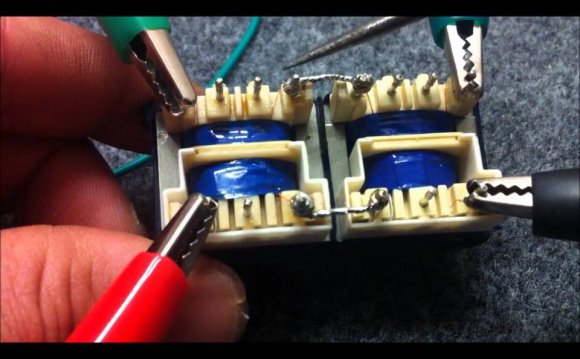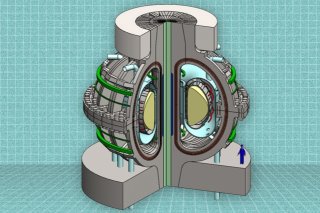
 Advances in magnet technology have allowed MIT scientists to design a cheaper, more compact, modular and highly efficient fusion reactor that is efficient enough to use commercially. The era of clean, practically inexhaustible energy may be upon us in as little as a decade, scientists report.
Advances in magnet technology have allowed MIT scientists to design a cheaper, more compact, modular and highly efficient fusion reactor that is efficient enough to use commercially. The era of clean, practically inexhaustible energy may be upon us in as little as a decade, scientists report.
The team used newly available rare-earth barium copper oxide (REBCO) superconducting tapes to produce high-magnetic field coils.
“[The implementation of these magnets] just ripples through the whole design, ” says Dennis Whyte, professor of Nuclear Science and Engineering and director of MIT’s Plasma Science and Fusion Center. “It changes the whole thing.”
Bigger bang for your magnet
But how do magnets help us build a mini-star? Well, fusion reactors generate electricity by using the same physical process that powers stars. In such a reactor, two lighter atoms are mushed together to create heavier elements. And just like natural stars, they generate immensely hot plasma – a state of matter similar to an electrically charged gas.
The stronger magnets and the stronger magnetic fields they generate allow the plasma to be contained in a much smaller space than previously possible. This translates to less materials and space necessary to build the reactor, and less hours of work, meaning a cheaper, more affordable reactor.
The proposed reactor, using a tokamak (donut-ish) geometry is described in a paper in the journal Fusion Engineering and Design, co-authored by Whyte, PhD candidate Brandon Sorbom, and 11 others at MIT.
Power plant prototype
The basic concept of the reactor and its associated elements rely on well-tested and proven principles that have been developed over decades of study.
The new reactor is intended to allow basic research on fusion and to potentially function as a prototype power plant – that could produce significant quantities of power.
 “The much higher magnetic field, ” Sorbom says, “allows you to achieve much higher performance.”
“The much higher magnetic field, ” Sorbom says, “allows you to achieve much higher performance.”
The reactor uses hydrogen fusion to form helium, with enormous releases of energy. To sustain the reaction and make it energy efficient (to release more energy than the reaction consumes) the plasma has to be heated to temperatures hotter than the cores of stars. And here is where the new magnets come in handy – they trap the heated particles in the center of the tokamak.
“Any increase in the magnetic field gives you a huge win, ” Sorbom says.
This is because in a fusion reactor, changing the strength of the magnetic field has a dramatic effect on the reaction: available fusion power increases to the fourth power of the increase in the magnetic field. Doubling the field would thus produce a 16-fold increase in the power generated by the device.
Ten times more power
The new magnets do not quite produce a doubling of the field strength, but they are strong enough to increase the power generation of the reactor ten times over previously used superconducting technology, the study says. This opens up the path for a series of improvements to be done to the standard design of the reactor.
The world’s most powerful planned fusion reactor, a huge device under construction in France called ITER, is expected to cost around US$ 40 billion. This device was designed and put into production before the new superconductors became available. Sorbom and the MIT team believe that their new design would produce about the same power as the french reactor, while being only half the diameter, cost but a fraction of its price and being faster to construct.
But despite the difference in size and magnetic field strength, the proposed reactor, called ARC, is based on “exactly the same physics” as ITER, Whyte says.
“We’re not extrapolating to some brand-new regime, ” he adds.
The team also plans to include a method for removing the fusion core from the reactor without having to dismantle the entire device. Being able to do this would lend well to research aimed at further improving the system by using different materials or designs of its core to improve performance.
In addition, as with ITER, the new superconducting magnets would enable the reactor to operate in a sustained way, producing a steady power output, unlike today’s experimental reactors that can only operate for a few seconds at a time without overheating of copper coils.
Molten core and liquid cover
Another key breakthrough the design of the reactor brings is that it replaces the blanket of solid materials that surrounds the fusion chamber with a liquid material, that can be easily circulated and replaced. This curbs operating costs associated with replacement of the materials that degrade over time.
“It’s an extremely harsh environment for [solid] materials, ” Whyte says, so replacing those materials with a liquid could be a major advantage.
In its current state, the reactor should be capable of producing about three times as much electricity as is needed to keep the reaction going. Sorbom says that the design could probably be improved and fine-tuned to crank up to about five or six times that much power. So far, no completed fusion reactor has produced energy (well they did, but they use more juice than they make) so the kind of net energy production ARC is expected to deliver would be a major breakthrough in fusion technology, the team says. They estimate that the design should be able to produce electricity for about 100, 000 people.
“Fusion energy is certain to be the most important source of electricity on earth in the 22nd century, but we need it much sooner than that to avoid catastrophic global warming, ” says David Kingham, CEO of Tokamak Energy Ltd. in the UK, who was not connected with this research. “This paper shows a good way to make quicker progress, ” he says.
The MIT research, Kingham says, “shows that going to higher magnetic fields, an MIT speciality, can lead to much smaller (and hence cheaper and quicker-to-build) devices.” The work is of “exceptional quality, ” he says; “the next step … would be to refine the design and work out more of the engineering details, but already the work should be catching the attention of policy makers, philanthropists and private investors.”
YOU MIGHT ALSO LIKE












